 |
 |
| Home | Welcome | What's New | Site Map | Glossary | Weather Doctor Amazon Store | Book Store | Accolades | Email Us |
 | |||||||||||||||||||||||||||||||||||||||||||||||||||||||||||||||||||||||||||||
Weather Almanac for February 2012THE COLDEST PLACES ON EARTH
|
|||||||||||||||||||||||||||||||||||||||||||||||||||||||||||||||||||||||||||||
| Location | Temperature |
| Antarctica, Vostok Station (Russia) | -89.2°C (-128.6°F) |
| Antarctica, South Pole (US Amundsen-Scott Station) | -82.8 °C (-117.0 °F) |
| Russia (Asian), Oymyakon | -67.7°C (-89.9°F) |
| Greenland, Northice | -66°C (-86.8°F) |
| Canada, Snag, Yukon | -63°C (-81.4°F) |
| United States, Prospect Creek, Alaska | -62.1°C (-80°F) |
| Russia (Europe), Ust’-Shchugor | -58.1°C (-72.6°F) |
| Mongolia, Uvs Lake | -57.8°C (-72°F) |
| United States (Contiguous States) Rogers Pass, Montana | -56.7°C (-69.7°F) |
| Afghanistan, Shahrak | -53.3°C (-64°F) |
| Kyrgyzstan, Astana | -53.3°C (-64°F) |
| Sweden, Vuoggatjalma | -52.8°C (-63°F) |
| China, Mohe | -52.3°C (-62.1°F) |
| Kazakhstan, Astana | -51.7°C (-61°F) |
| Finland, Kittilä | -51.5°C (-60.7°F) |
| Norway, Karosjok | -51.4°C (-60.5°F) |
| North Pole | -50.6°C (-59°F) |
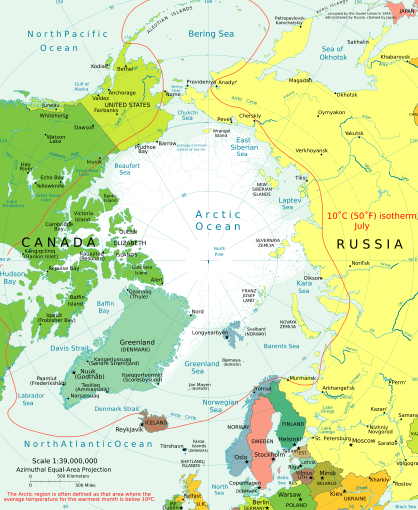
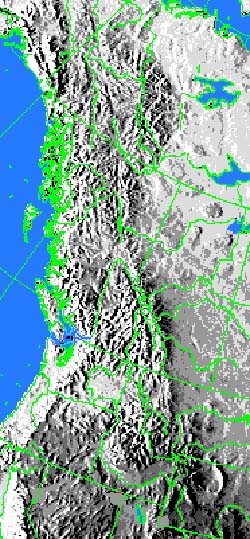 The coldest officially accepted temperature in North America outside Greenland was recorded in February 1947 in Snag, Yukon, during an historic cold period in late January and early February. I have documented the record of -63°C (-81.4°F) at Snag and extreme cold surrounding locations in Canada and Alaska elsewhere on this site.
The coldest officially accepted temperature in North America outside Greenland was recorded in February 1947 in Snag, Yukon, during an historic cold period in late January and early February. I have documented the record of -63°C (-81.4°F) at Snag and extreme cold surrounding locations in Canada and Alaska elsewhere on this site.
The topography surrounding Snag is ideal for trapping cold air. Snag is tucked away in the southwestern Yukon in a bowl-shaped valley of the White River, a tributary of the mighty Yukon River. With the Wrangell, St Elias and Chugach Mountain ranges forming a high barrier around the region, the flow of milder Pacific air into the area is effectively blocked. This leaves it open to the frigidly cold air masses of the western arctic. Additionally, the broad valley terrain surrounding Snag allows cold air to drain down the north slopes of the coastal mountains to accumulate in low areas of the valley.
As a result, January in Snag reported average daily maximum temperatures at a chilling -25.1°C (-13.2°F), and average daily minimum temperatures at a frigid -35.6°C (-32.1°F). The thermometer reading regularly dipped below -50°C (-58°F) during that month.
Like Greenland, the coldest Canadian temperatures are not found in the furthest north regions, the island of the Arctic Ocean basin. The nearness of the ocean waters, even if its surface is frozen over for months of the year, ameliorates the air temperatures enough that the “cold spot” of Canada is found further inland.
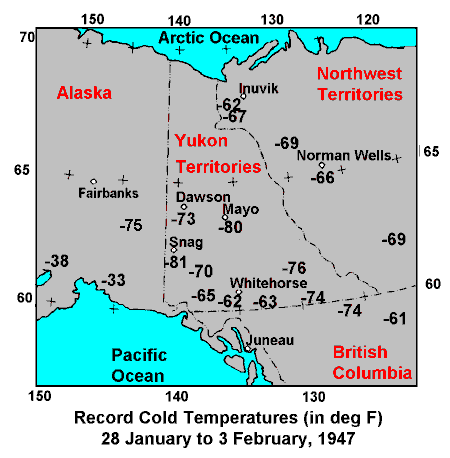
Other areas of northwestern Canada have similar topographic characteristics to Snag and have also seen very cold individual temperature readings. Several official climate stations have reported temperature readings below -65°C (-85°F). As well, two locations used in a permafrost study in a mountain valley near Fort Nelson, British Columbia reached unofficial lows of -71.1°C (-96°F) and -68.9°C (-92°F). The official low recorded that day at Fort Nelson was a relatively “warm” -42°C (-43.6°F).
| Canada, Snag, Yukon | -63°C (-81.4°F) |
| United States, Prospect Creek, Alaska | -62.1°C (-80°F) |
| United States (Contiguous States) Rogers Pass, Montana | -56.7°C (-69.7°F) |
Given the thousands or millions of pocket valleys in the mountains of northwestern Canada, it would not be surprising that the right combination of conditions could produce spot temperatures lower than -62°C (-80°F). The same could be said of high elevation sites in this area. The sixteen highest peaks in Canada are found in the St Elias range south of Snag. A spot reading on Mt Logan, Canada’s highest peak located in the St Elias range, dropped to an amazing low of -77.5°C (-107.5°F) in May 1991 at an elevation above 6000m (19,670 ft).
British Columbia’s official coldest mark was set during the same cold wave as the Snag reading, a frigid -58.9°C (-74°F) on 31 January 1947. Outside of extreme northwestern Canada, the coldest reading occurred at Ft Vermillion, Alberta with a near-national record of -61.1°C (-78°F) on 11 January 1911. Excluding the Maritimes Provinces, the coldest recorded temperatures in all Canadian provinces and territories has dropped below -50°C (-58°F) including Newfoundland.
The American state of Alaska shares many of the same characteristics that produce extreme cold in northwestern Canada. Inland areas of the state have many similar pocket valleys in which cold can build. The official coldest single reading -62.1°C (-79.8°F) in Alaska was observed at Prospect Creek along the Alaska pipeline route on 23 January 1971. Chris Burt reports that on the same day, a storefront thermometer in the community of Coldfoot (40 miles north of Prospect Creek) showed a temperature of -63.3°C (-82°F) while the “official” reading for Coldfoot only reached -58.9°C (-74°F). If only permanently inhabited locations are considered, the record cold falls to Fort Yukon, a -61.1°C (-78°F) mark on 14 January 1934. At least nineteen locations across Alaska have reported an official low temperature below -56.7°C (-70°F).
As I was finalizing this piece, Chris Burt commented in his Weather Underground blog that a near record low temperature was reported at Jim River, Alaska in the waning days of January 2011. The as yet unverified reading was -61.2°C (-79°F) at a remote recording site at Jim River, a location not far from Prospect Creek, on 28 January. If verified, it would be the second coldest accepted temperature measured in both Alaska and the US. Note that the region around Jim River and Prospect Creek is know to be one of the coldest in Alaska for absolute minimum temperatures.However, on further investigation, the US National Weather Service reviewed the sensor and found the reading to be incorrect, at the personal weather station there.
Cold has been the rule in Alaska during much of the Winter of 2011-12 with Fairbanks having temperaturs below -40°C/F on 17 days in January. On the 30th, the official low at Fort Yukon was -54.4°C (-66°F).
 |
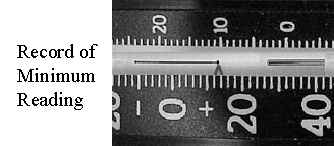 |
However, if we allow for spot marks at high elevation, a minimum thermometer left on Denali (Mt McKinley) by the US Army Natick Laboratory from 1950 to 1969 at an elevation of about 4,570m (about 15,000 ft) showed its lowest reading at -73.3°C (-100°F). It would therefore not be surprising to find temperatures at elevation of in pocket valleys that have been colder than the Prospect Creek location.
Further south in the contiguous 48 states, the record for cold temperature belongs to Rogers Pass, Montana with a frigid -56.5°C (-69.7°F) on 20 January 1954. Only six other states have official record lows of -51°C (-60°F) or below: Colorado, Idaho, Minnesota, North Dakota, Utah and Wyoming.
Minnesota and North Dakota are both located in the Red River valley of the US northern extremes of the Great Plains and along one of the prime tracks of frigid arctic air descending southward from the Canadian Arctic and even Siberia. The other three states share the high plateaus and mountainous terrain of the Rocky Mountain cordillera with Montana.
There have been other readings of -51°C (-60°F) or below in the lower 48 states besides the state records. Most have been in the same area along the Rockies, with Montana, Wyoming, Idaho, Colorado and Utah having multiple locations. A few of these extreme lows have been in eastern Montana in the northwestern Great Plains. Unofficial readings of -51°C (-60°F) or below have also been reported in Rochford, South Dakota and Embarrass, Minnesota.
The official Utah mark of -56.3°C (-69.3°F) occurred at Peter’s Sink, a low area in the Wasatch Mountains, on 1 February 1985. The location is no stranger to cold as its lowest January temperature -54.4°C (-66°F) came on the same day as the Roger Pass minimum.
The influence of the continental cold centered in Siberia extends further south to the Himalayan Mountains. While this area of high plateau and mountains is not considered the coldest in Asia, it still holds some of the coldest areas on the planet. Indeed, in the high Himalayas at its southern boundary, the coldest surface temperatures anywhere in the hemisphere may be lurking around the high elevations of Everest or K2, or other lofty summits.
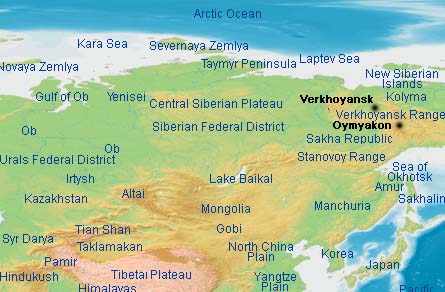
Extreme cold, however, is no stranger to lower elevations where the people of central Asia reside. The Siberian High, typically centered over the Lake Baikal region of Siberia, has its influences over a wide extent of the Eastern Hemisphere (and occasionally spills it cold air over the pole to the Western Hemisphere). The strongest semi-permanent high in the Northern Hemisphere, it can influence the weather as far west as Italy and central Europe and southward in Asia where it affects the monsoon climates of the Indian Subcontinent, Southeast Asia and surrounding islands. It may at times spill over into the subtropical regions of Southeast Asia bringing cold weather to The Philippines and other locales.
| Location | Temperature |
| Russia (Asian), Oymyakon | -67.7°C (-89.9°F) |
| Mongolia, Uvs Lake | -57.8°C (-72°F) |
| Afghanistan, Shahrak | -53.3°C (-64°F) |
| Kyrgyzstan, Astana | -53.3°C (-64°F) |
| China, Mohe | -52.3°C (-62.1°F) |
| Kazakhstan, Astana | -51.7°C (-61°F) |
Its influence is greatest in Mongolia, northern China, Afghanistan and the former Soviet republics of Kyrgyzstan and Kazakhstan. Each of these countries have record low temperature readings of -51°C (-60°F) or below as shown in the table above.
The warming influence of the North Atlantic Ocean and the Arctic Ocean tempers the climate of Northern Europe to the extent that extreme temperatures even in the regions north of the Arctic Circle are mild compared to northern Asia and North America. The coldest recorded temperature in Europe occurred in European Russia at the village of Ust’-Shchugor on 31 December 1978. That morning it dipped to -58.1°C (-72.6°F). The village lies just west of the Ural Mountains in extreme Eastern Europe. North of Ust’-Shchugor, the community of Pechora has been nearly as cold, reporting a low of -56°C (-68.8°F) on 9 February 1946. These sites lie about 250 km (150 miles) south of the Arctic Circle in the Pechora River valley.
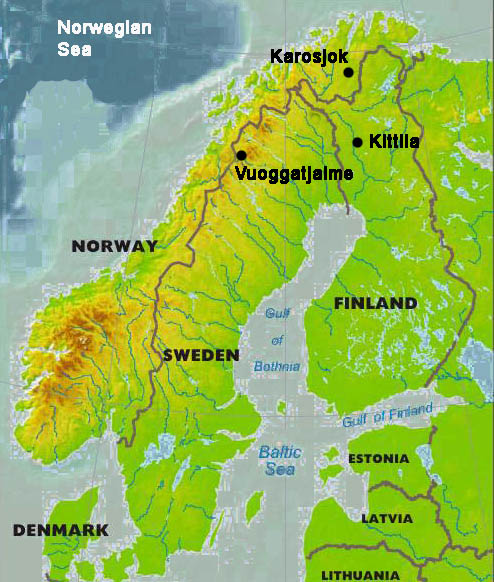 Three Nordic countries have registered temperatures of -51°C (-60°F) or below: Sweden, Finland, and Norway. Denmark’s climate is so influenced by surrounding marine conditions that its record low temperature is actually warmer than that of Spain. Similarly for Iceland, whose low is just below that of Romania. Neither mark falls below -40°C/F.
Three Nordic countries have registered temperatures of -51°C (-60°F) or below: Sweden, Finland, and Norway. Denmark’s climate is so influenced by surrounding marine conditions that its record low temperature is actually warmer than that of Spain. Similarly for Iceland, whose low is just below that of Romania. Neither mark falls below -40°C/F.
The officially recognized low temperature in Sweden, and by extension Western Europe, is -52.6°C (-62.7°F) at Vuoggatjalme in Norboten County on 2 February 1966. Two other readings in Sweden have fallen below that mark. The coldest, registered on a private thermometer in Malgovik, Vasterbotten County, came on 13 December 1941: -53°C (-63.4°F), which the Swedish meteorological service certified at the time as being correct. There is also an unofficial report of a low temperature of -54°C (-65.2°F) measured at a church in Karesuando, located near the Finnish border. Both Vuoggatjalme and Karesuando are above the Arctic Circle, the former on a river valley coming out of the Kjølen Mountains west of the northern border with Norway.
| Location | Temperature |
| Russia (Europe), Ust’-Shchugor | -58.1°C (-72.6°F) |
| Sweden, Vuoggatjalma | -52.8°C (-63°F) |
| Finland, Kittilä | -51.5°C (-60.7°F) |
| Norway, Karosjok | -51.4°C (-60.5°F) |
The Finnish record low is -51.5°C (-60.7°F) measured at Kittilä on 28 January 1999. This location is Lapland in a river valley. The official Norwegian low temperature is -51.4°C (-60.5°F) at Karasjok, located in Finnmark in extreme northern Norway near the Finnish border in a river valley on the Finnmark Plateau and about 150 km (94 miles) south of Kittilä. That temperature was reached on 1 January 1886. Both sites lie above the Arctic Circle.
As with other areas discussed above, the coldest temperature in Europe may not be located in places where official measurements are taken. Higher elevations or pocket valleys near high elevation in Scandinavia or perhaps the Alps may have colder temperatures that those recognized officially. Chris Burt reports two such readings in pocket valleys or sinkholes, known as dolines, that have recorded temperatures below -51°C (-60°F). These were in Austria — -52.6°C (-62.7°F) — near Grunloch in the late winter of 1932; and in Glattalp, Schwyz Canton, Switzerland — -52.5°C (-62.5°F) — on 7 February 1991.
Very cold temperatures have been recorded in nations across Europe; twelve countries have record lows below -40°C/F.
For the continents of South America, Africa, and Australia, their distance from the polar latitudes keeps them from having extremely cold temperatures, except perhaps at high elevations. Only the southern tip of South America even approaches the Antarctic Circle — Cape Horn is less than a degree south of 55 degrees South latitude.
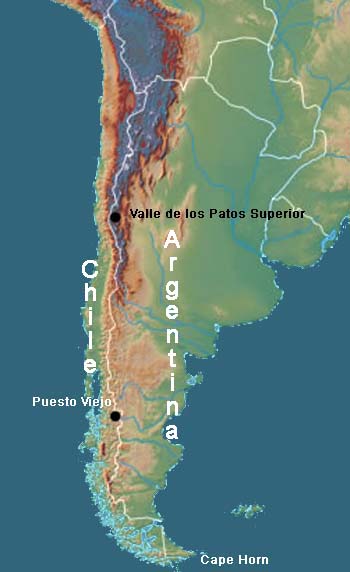 The southernmost regions of Chile and Argentina, however, do not have the coldest official temperatures in these nations. A low of -40°C/F has been reported for Puesto Viejo, Chile on 21 June 2002. This location is an uninhabited location in a mountain pass between Chile and Argentina at an elevation of 865 m (2838 ft) at 45 deg, 20 sec S. This temperature occurred during an extreme cold spell for Chile with at least three sites reporting temperatures below -25°C (-13°F). A low of -37°C (-34.6°F) was also recorded that month at Coyhaique Alto in Patagonia.
The southernmost regions of Chile and Argentina, however, do not have the coldest official temperatures in these nations. A low of -40°C/F has been reported for Puesto Viejo, Chile on 21 June 2002. This location is an uninhabited location in a mountain pass between Chile and Argentina at an elevation of 865 m (2838 ft) at 45 deg, 20 sec S. This temperature occurred during an extreme cold spell for Chile with at least three sites reporting temperatures below -25°C (-13°F). A low of -37°C (-34.6°F) was also recorded that month at Coyhaique Alto in Patagonia.
The coldest measured in Argentina was -39°C (-38.2°F) on 17 July 1972 at an uninhabited site at Valle de los Patos Superior in San Juan Province. It is actually fairly far north (between 30 and 33 deg S) but in a high mountainous region near the Chilean border.
As with other locations, lower temperatures in South America may have occurred at higher elevations. One such reading was a temperature of -44°C (-47.2°F) at a high elevation site at the Veladero Mine along the Chilean border in Argentina in July 2004.
For more on the world’s cold spots, I refer the reader to Christopher Burt’s Weather Extremes blog: “The Coldest Places on Earth” on Weather Underground from which much of the above data was extracted. His book Extreme Weather also contains added information on cold places. To order, see the listing below.
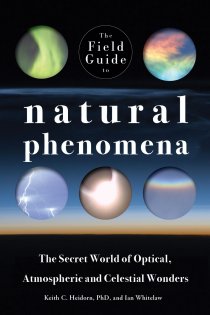 |
Now AvailableThe Field Guide to Natural Phenomena: |
Now Available! Order Today! | |
 |
 |
Now |
The BC Weather Book: |


